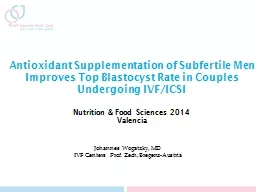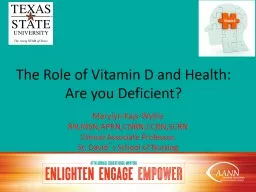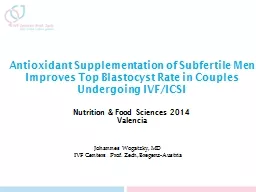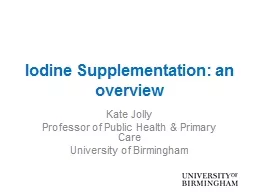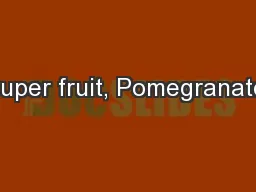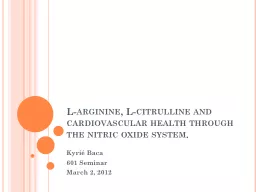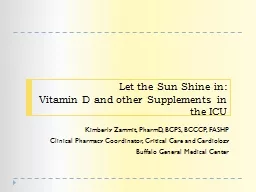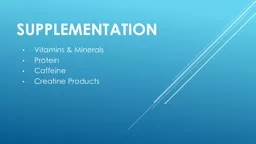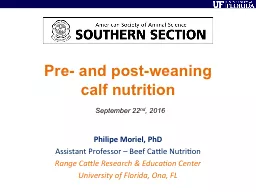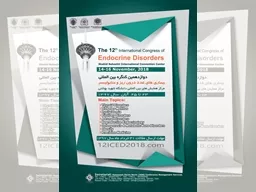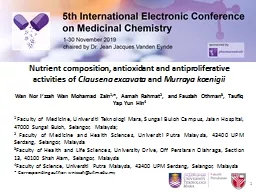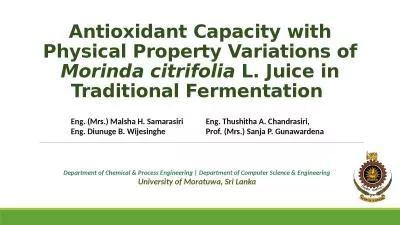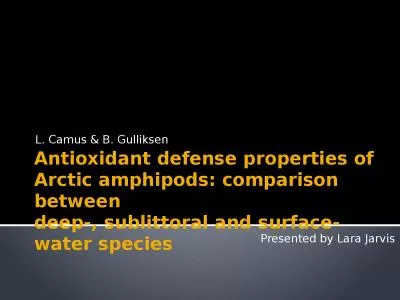PPT-Antioxidant Supplementation of
Author : conchita-marotz | Published Date : 2016-07-23
Subfertile Men Improves Top Blastocyst Rate in Couples Undergoing IVFICSI Nutrition amp Food Sciences 2014 Valencia Johannes Wogatzky MD IVF Centers Prof Zech BregenzAustria
Presentation Embed Code
Download Presentation
Download Presentation The PPT/PDF document "Antioxidant Supplementation of" is the property of its rightful owner. Permission is granted to download and print the materials on this website for personal, non-commercial use only, and to display it on your personal computer provided you do not modify the materials and that you retain all copyright notices contained in the materials. By downloading content from our website, you accept the terms of this agreement.
Antioxidant Supplementation of: Transcript
Subfertile Men Improves Top Blastocyst Rate in Couples Undergoing IVFICSI Nutrition amp Food Sciences 2014 Valencia Johannes Wogatzky MD IVF Centers Prof Zech BregenzAustria IVF ICSI technique was first induced 1990 At . We determined whether supplementation with coenzyme Q10 CoQ10 could decelerate aging in SAMP1 mice and its potential role in aging Plasma concentrations of CoQ10 and CoQ9 decreased with age in SAMP1 but not in SAMR1 mice Supplementation with reduced Marylyn Kajs-Wyllie. RN,MSN,APRN,CNRN,CCRN,SCRN. Clinical Associate Professor, . St. David. ’. s School of Nursing . Objectives. Describe the physiologic functions of Vitamin D.. Relate the effects of Vitamin D deficiency to multiple disease states.. Subfertile. Men Improves Top Blastocyst Rate in Couples Undergoing . IVF/ICSI. Nutrition & Food Sciences 2014. Valencia. Johannes Wogatzky, MD. IVF Centers Prof. Zech, Bregenz-Austria. IVF/ ICSI technique was first induced 1990. At . Kate Jolly. Professor of Public Health & Primary Care. University of Birmingham. Methods of iodine supplementation. Salt fortification with iodine. Universal: fortification of all salt for human and animal consumption (USI). A . light on phytochemicals and their benefits to the human . health. Zainab. Mansur(ZM) Yan Yang(YY) . Diana Juarez(DJ) Akshata Kulkarni (AK). Introduction. . Zainab. Kyrié Baca. 601 Seminar. March 2, 2012. Cardiovascular Disease . Number 1. cause of morbidity and mortality among adults in the United States.. Atherosclerosis. : inflammatory disease characterized by vascular endothelial dysfunction and . Kimberly Zammit, . PharmD. , BCPS, BCCCP, FASHP. Clinical Pharmacy Coordinator, Critical Care and Cardiology. Buffalo General Medical Center. Disclosures. None to report. Learning Objectives. Identify . Protein. Caffeine. Creatine. Products. VITAMINS AND MINERALS. Vitamins . and minerals are organic compounds found in high concentrations in fruit and vegetables. Though they are all needed for proper bodily function, there are a few that are important for performance.. . September 22. nd. , 2016. Philipe Moriel, PhD. Assistant Professor – Beef Cattle Nutrition. Range Cattle Research & Education Center. University of Florida, Ona, FL. BOVINE RESPIRATORY DISEASE. , 2018. . پنجشنبه 24 آبان 1397. بنام خدا. Ergocalciferol. Cholecalciferol. Formula. C. 27. H. 44. O. Formula. C. 28. H. 44. O. Vitamin . D . is synthesised in the . skin. . by the action of . antiproliferative. activities of . Clausena. . excavata. and . Murraya. . koenigii. Wan Nor I’zzah Wan Mohamad Zain. 1. ,. *, . Asmah Rahmat. 2. , and . Fauziah Othman. 3. , Taufiq Yap Yun Hin. M135 - - cachetic patients undergoing oncologic treatments. Adilson Faccio, MD; PhD 1 ; Cecilia Mattos, M.Sc. 1 ; Evandro dos Santos, MD 1 ; Natael Neto, MD 2 ; Raquel Moreira, MD 3 ; Luciara Bat Morinda . citrifolia. . L. Juice in Traditional Fermentation . Department of Chemical & Process Engineering | Department of Computer Science & Engineering. University of Moratuwa, Sri Lanka. deep-, . sublittoral. and surface-water species. L. Camus & B. Gulliksen. Presented by Lara Jarvis. ROS. Reactive molecules that contain oxygen atoms. Reactive because of presence of unpaired valence shell electrons.
Download Document
Here is the link to download the presentation.
"Antioxidant Supplementation of"The content belongs to its owner. You may download and print it for personal use, without modification, and keep all copyright notices. By downloading, you agree to these terms.
Related Documents

